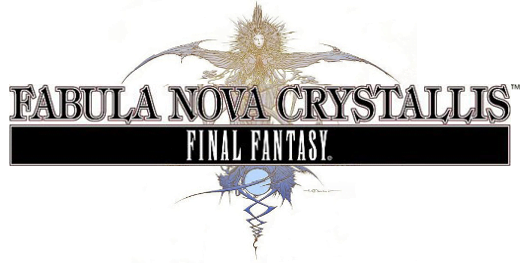Once upon a time, this was a Game Pile about Final Fantasy XIII-2. Then it became an examination of Final Fantasy XIII, as the grounding work for XIII-2. And then, like an archaeologist probing at the edges of a shape, tenatively touching and nudging, I learned the secret. I learned that beneath the shape of Final Fantasy XIII and all the way through to Final Fantasy XV, there was something.
There was a brand.
I started this examination with the best of intentions, the absolute kindest of intentions, I really did. I just wanted to talk about a big JRPG, maybe play through it most of the way, talk about how modern JRPGs have changed, and compare them to my early experiences. It was gunna be fun. I had a few hundred words on menu-based combat and references to Final Fantasies 5 and 6, the ones I like the best. I was going to lead to this sort of ‘change is good’ conclusion that accepted that just because things weren’t the way they were in 1995 doesn’t mean they’re actually bad. I had a trajectory! I had an arc!
It was meant to be basic!
But as you can tell, thanks to the subject, I didn’t get there.
Instead, we’re going to talk about Final Fantasy XIII-2‘s underlying vision, and the Accidentally Lesbians.
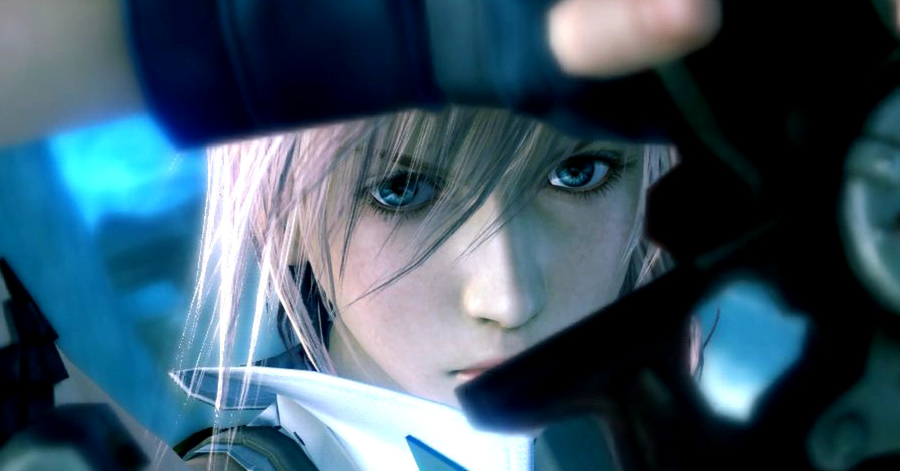
Okay, so if you’re not familiar with this iconography and the style or what I’m talking about when I try to drag together this community of content, let’s see how comprehensively I can explain this to you in the limited time we have before the heat death of the goddamn universe. Supposedly created as a single shared mythology base for a set of Final Fantasy games under the title Fabula Nova Crystallis, this mess of stuff is comprised of the following entries in this bulleted list:
- Final Fantasy XIII, a big chunky JRPG that scored a solid Meh out of Ten,
- Final Fantasy Type-0, a sort of real-time strategy game sorta JRPG,
- Final Fantasy XIII-2, a direct sequel to Final Fantasy XIII and the source of this article, in a way,
- Lightning Returns: Final Fantasy XIII, a direct sequel to XIII-2, and if you’re following the naming convention, no, it doesn’t make any sense,
- Final Fantasy Agito, an online multiplayer game that was only launched in Japan and no longer exists,
- Final Fantasy XV, the 2016 car boys videogame, until ‘car boys’ became a really awkward thing to mention positively, and finally,
- Final Fantasy Awakening, which is an online multiplayer game that launched after Agito shut down.
The thing is this isn’t even all of it, because each of these games has some spinoff material that supposedly makes up some of its game space, including Final Fantasy XIII Corridor of Memory (a booklet), Final Fantasy XIII-2: Chronicle of a Chaotic Era (a book), Final Fantasy XIII Reminiscence: tracer of memories (a novella), an expansion for the Final Fantasy collectable card game, the manga serialisations, plural, of Type-0, Final Fantasy Type-0 Side Story: Reaper of the Icy Blade, which isn’t the same thing as the manga paired series of Final Fantasy Type-0: Change the World -The Answer-, Final Fantasy Type-0: Change the World Volume 2 -The Penultimate Truth-, an in-game novelisation of Final Fantasy XIII in Final Fantasy XIII-2 that you can read right at the start, and then there’s a pair of tie-in novels, Final Fantasy XIII-2: Fragments Before and Final Fantasy XIII-2: Fragments After. Then when you move on to Final Fantasy XIII: Lightning Returns, to my amazement they didn’t tie in an extra book or novel or manga, but you could buy a variety of costumes including one of Lara Croft with realistic face-beating bruises, then next there’s Final Fantasy Agito’s tie-ins, which were somehow less common, maybe tied to the fact the game had purchaseable outfits as well, which I’m sure is a coincidence. Then we get to Final Fantasy XV, which in addition to its own DLC empire and real-life advertising for actual real life products with the in-game avatars, we saw Kingsglaive: Final Fantasy XV (a movie), Brotherhood: Final Fantasy XV (a net series), Monster of the Deep: Final Fantasy XV (a VR game), and Final Fantasy XV: A New Empire (a freemium phone game with tower defence and pay-to-wait mechanics).
Now a sensible person might ask why did I cover all that? Why? What did it serve? Well because I dedicated over an hour of my life to this to collecting this information and someone has to feel my pain. Every single one of these seven games has at least one book, most have multiple books, there are CCG expansions and web comics and an anime and a movie, and numerous director’s cut style expanded releases and other whole games and there is just
so
much
stuff.
This stuff is all meant to be formed from and therefore reflect a single, greater shared mythical space, building on the central themes of the Fabula Nova Crystallis.
What’s Fabula Nova Crystallis, you ask, even though I just told you, but okay, fine, fine, let’s try and clear this up for those in the lecture who didn’t do the reading.
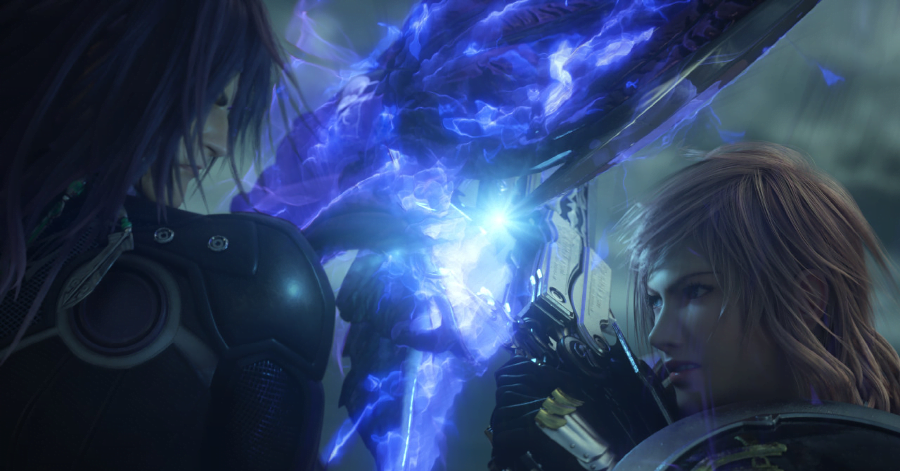
There are three things Fabula Nova Crystallis means. One is the shared mythology of all these games, which up front, I can’t really comment on. I mean, I haven’t played all these games. Hell, I can’t, some of these games can’t be played any more. I’m going to say some things about this thing –
I’m going to say some hurtful things,
– and I want to make sure I don’t misrepresent things here. I’m not talking about that mythology here. I’m talking about the marketing brand, and the development cycle of these games. Particularly, I understand this mythology is consistant in the “Lightning Saga,” and that’s completely disconnected from the mythologies of the other things that Fabula Nova Crystallis is meant to be connected to!
Anyway, if you believe what it says on the dust jacket, Fabula Nova Crystallis is a grand project, a new centralised mythology which connects the texts of the related Final Fantasy games. Announced in 2006 along with the titles of games that wound up becoming that laundry list above, this grand project would allow the creation of Final Fantasies that would live up to the reputation of the brand that most commentators felt had peaked in in 1997, which is okay, because commentators who aren’t me get to be wrong a lot, because it actually peaked in 1994, 7 wasn’t very good, fight me. The notion was to take the previous elements of all Final Fantasy games and remix them, together, as one single central mythology that could be used to make a bunch of different games, promising the best of what was in the past, updated for now, and by now, we mean thirteen years ago.
There’s potential in the idea! There wasn’t at the time a real continuity of narrative for Final Fantasy games as much as there is a continuity of style; they’re more defined by having things, having stuff, like their own trope language, similar and familiar characters and weapons and key words of myth, but not actually any similar central moral framework or story foundation. Final Fantasy 6 had ideas that informed its story like the meaningful impact of parents on children, even absentee parents, about the ways we honour the dead, about choices we make to spare other people and about saving the world even when the world you’re saving is in ruins, which is great, and it’s great, but by comparison you could make a case that Final Fantasy 12 had themes like ‘Star Wars was really cool.’ So you could get games with Shiva and Ifrit and Cid and the Masamune all piling up against one another and sometimes those things would tell you that you need to stand on your own and sometimes they’d tell you you don’t exist except in the minds of the people you help.
The idea seems to be that if the mythology, themes, and ideologies of the next few games were all made at once, and made to work under one banner, the games could come out with a clear vision of what they are, what they wanted to be, and what that meant, and that could result in good stories because these games are about telling stories and not, as one might cynically assess, selling merchandise and marketing noodles.
It said it was about a mythology, but this ‘mythology’ spread across all these potential games was more of a hype machine, something that could promise a bunch of games and stories. This meant they could keep interest in their games and branding, even though these games had long development times. The lure, the promise of multiple games in development that would release in a reasonably quick time frame was exciting and by branding it, they got to give this set of games an identity, an identity that excited people and shareholders. At the time, for some reason, people thought of Final Fantasy games as being about games and stories and not just ‘boy hot’ or the next level, ‘girl hot.’
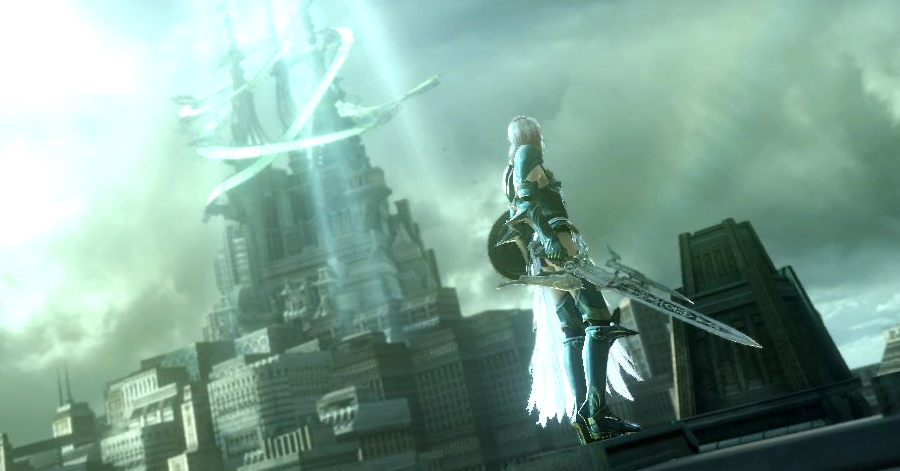
Anyway, that’s the idea. It didn’t happen, not really. It couldn’t!
First of all, for one of these announced games, that became Final Fantasy XV, the development time was so long we had literal public cultural shifts in markets. For perspective, this project was announced in 2006, and the iPhone launched in 2007. The Wii, the little white box that could, launched after they announced this project. The ten years it took to get from announcement to release of Final Fantasy XV represent a genuinely cataclysmic shift in global games culture. It’s not like these shifts were subtle, either, nor the impact they had on the games in development. We’re not even going to talk about Final Fantasy XV, though – pointing out how a ten year dev cycle falls to bits is too easy. Plus, while the Fabula Nova Crystallis was meant to enable a game like Final Fantasy XV to get released quickly, it did not get released quickly, and had to have its mythology sheared away from the Fabula Nova Crystallis, which suggests it’s not actually much use.
Let’s instead focus on Lightning, and her games, and what they show us about the Fabula Nova Crystallis.
It was only three years after this announcement and the release of Final Fantasy XIII, and its development was pretty torturous. Initially, this game was a Playstation 2 game, then it moved to Playstation 3, and that infamously required a whole new engine and a full revamp of all the art assets. Its presentation in 2006 was simply made up – almost none of what you saw in that presentation was in the final game, and according to the developers, the enormous game that is Final Fantasy XIII was developed in a truncated window of time starting around 2007 and launched in 2009 – maybe a touch less than two years. During this time they also had to make their own dev kit and there were restarts – it was, generally, a mess. Did you know back in the original design combat was meant to be seamlessly integrated with the live map and Lightning was meant to have anti-gravity powers that let her transform the battlefield?
None of that wound up being true, because that whole trailer was just a trailer. It wasn’t representing a thing that existed. And then over two years, over two hundred people working on two games at once with no unified vision released Final Fantasy XIII.
The game is a real example of the failures of crunch, incidentally. Watch the game sometime, you’ll notice times characters bring up topics like they’ve already been discussed, because the earlier scenes with that conversation just got cut or reordered. The story seemed to want to talk about trying your hardest and making your friends and coming together so you could succeed at a mission from god, who would then kill you for your succeeding.
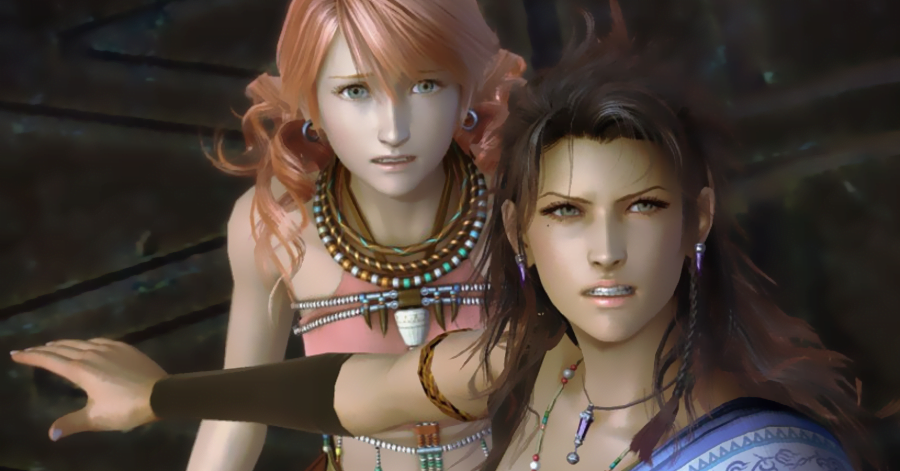
Now, the Accidentally Lesbians.
There was a point in this two-year development cycle when the character of Fang was some other character. This character had had a romantic relationship in the past with Vanille – and the change to Fang was done with minimal change to Vanille and her dialogue with some lines not even being rewritten, and, according to some sources, not even being rerecorded (which, if true, suggests they were recording game audio before the story was finalised). Fang was going to be a dude, and Lightning was going to be flirty, and they decided to change that by putting the lines from Lightning into Fang, making Fang a girl, and then giving Fang a need to protect Vanille.
All of this resulting in Fang and Vanille being coded as extremely gay, the kind of gay that’s so comfortable and present that nobody remarks on it, creating a sort of gayness-beyond-gayness, punching through the normal representational boundary and standing on the other side in a world where heterosexuality is so much not the default that it is literally unremarkable to find that default abrogated. Now, you may be a big fan of this, and if you are, cool, go team lesbian, but this was absolutely a complete accident and budget constraints, and not a byproduct of this mythos creating a space to wave the lesbian flag.
The game finally came out, the game got released, and people didn’t like it. They talked about things the game did badly and they talked about the bad plot and they talked about it being boring and meh and technically impressive but also pretty rubbish.
The developers, of course, got immediately pissingly petty.
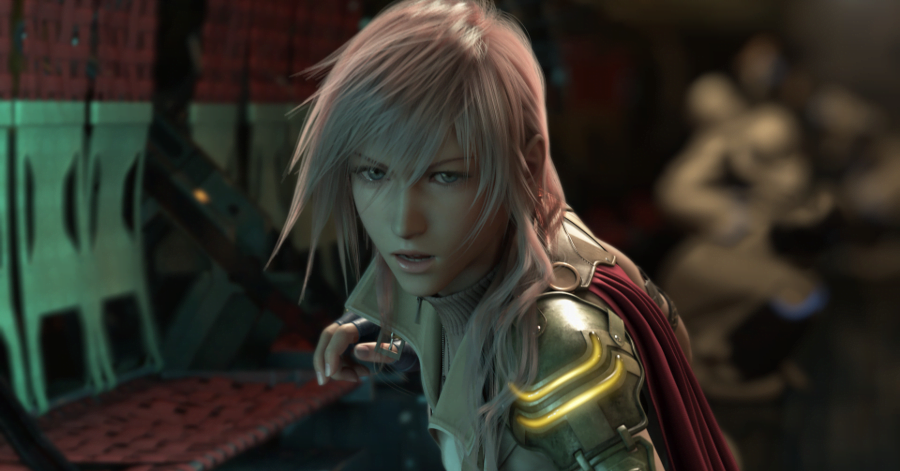
Motomu Toriyama, director of the game, claimed that the people who disliked his game disliked it because they were approaching it from a Western point of view, and the complaints about the game’s linearity were at odds with his desire to tell a story, which is so silly I don’t feel like making a creative metaphor to dismiss it. Another fun claim from Yoshinori Kitase was that the developers “didn’t really intend to work within the RPG template,… [we] wanted to create a new game, even a new genre… In a lot of senses FFXIII is more like an FPS than an RPG.”
They basically blamed the fans for not liking their story, and said their focus on the story was why they made a game the audience didn’t like, because nobody will call you on saying contradictory nonsense in an interview, it seems. In 2011, Kitase did concede that the game really needed more ways to interact with the world, which he interpreted as more mini-games, and that players saw the way the game locked so much system information and gameplay elements behind hours and hours and hours and hours and hours and hours and hours and hours of playing as a ‘long tutorial,’ which is a completely reasonable thing for players to do.
Anyway, point is, they had this new mythology, this new direction this new characterisation, a direct stated goal of remixing their grand and beautiful history of the best RPGs ever released, and their first foray into it was a bad game and they blamed their fans for being too American to get it.
Great first step there.
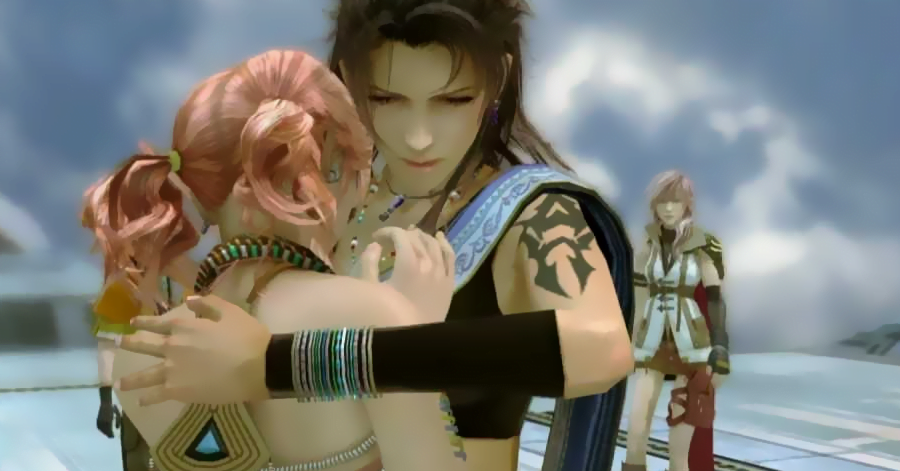
What followed this stumbling first step of Let’s Have This Cool New Character We Don’t Know What To Do With was a festival of absolute clown shoesry. I’m not talking about the games in this sequence but rather the creative direction that’s meant to connect back to this central mythology of Fabula Nova Crystallis. There was story DLC that tried to fix things, then there was the tie-in media, then… nothing. The needle sat firmly at ‘meh.’
With the lackluster denoument of Final Fantasy XIII, they returned to the drawing board to release Final Fantasy XIII-2, a game built around a kind of literalisation of the question of what to do in a world that doesn’t think you exist, which, look, as a queer theme goes, that’s a hell of a place to start. Like, literalising the invisibling of the identity of the marginalised and then letting that person play destiny-wrecker pokemon trainer, but with dragons, that has potential. Even describing it now sounds cool, to me, damnit. Yet at the same time, showing this ‘story’ problem, Final Fantasy XIII-2 starts with a write-up of the events of the previous game so you could be sure you understood what really happened, you dunderhead.
It’s literally a writeup. A great big wall of text that it slowly reads to you.
What ensued for the next oh, six years or so, was a steady release of new games and DLC trying to patch together this plot and introduce new elements of the mythology that would ‘fix’ or ‘explain’ all the things that came before it, including splitting the fal’Cie into parts, changing the rules of how l’Cie worked, ditching the terms entirely because players kept getting confused by them and eventually using a whole game to throw this entire mythology as expressed in this world into a woodchipper. In a stroke of genius, they made a whole game about playing Lightning getting all her friends together and hucking all of them through the continuity hole that let them exist in the next, new, better world, we promise, The End.
This cluster of continuity mangling, this non-stop effort to ‘fix’ the story by adding more story was so bad that Lightning Returns: Final Fantasy XIII actually had a note on its box that the plot was complete, and you wouldn’t need to buy DLC.
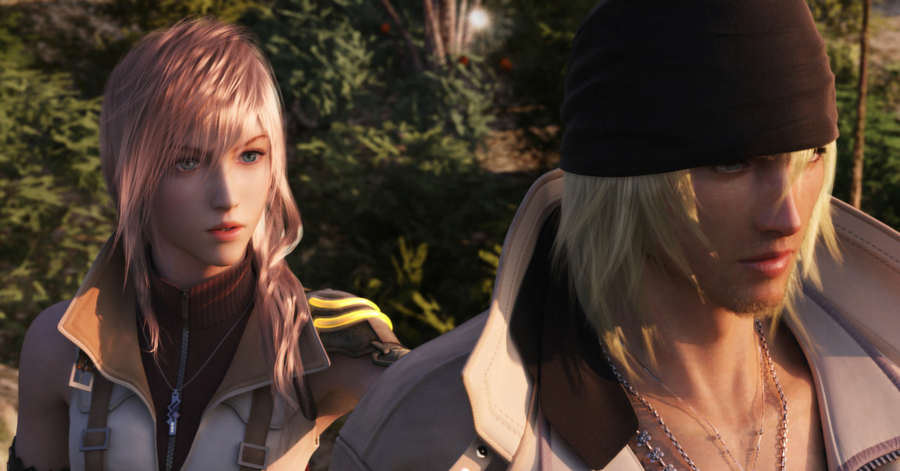
No, the DLC for that game was all costumes, so you could put Lightning, the stern and militant woman whose whole plot centered on her being emotionless and regimented and no-fun-at-all, in a catgirl costume where she would pose to show you her boobs. Because like I said, these developers had succesfully reached the storytelling plateau of ‘girl hot.’
What this meant for me, researching this, is that the ‘central plot’ of this text is spread across eighteen sources, many of which are partially redundant, but all of which are meant to represent this same, central, mythical space of the Fabula Nova Crystallis. The hypothetical is that this mythology gives these games a clear vision of what they’re ‘about,’ yet the development cycle of all these games are marked by the same, persistent problem: Troubled Development, and a Lack Of Unified Vision. Rather than a singular coherent narrative direction, you get this regular intrusion of directorial confusion detonating within each game and creating these story chunks that are all excellently polished and well crafted and completely disconnected from one another.
By demanding story endlessly, and without any clear direction for what those stories should be about, Fabula Nova Crystallis created a whirlpool of sucking, complicated, interconnected stuff that could never be harmonised together, all in the name of constantly creating content to assert there was meaning in their noise.
What happened to Kingdom Hearts happened to Final Fantasy.
Final Fantasy done got norted.
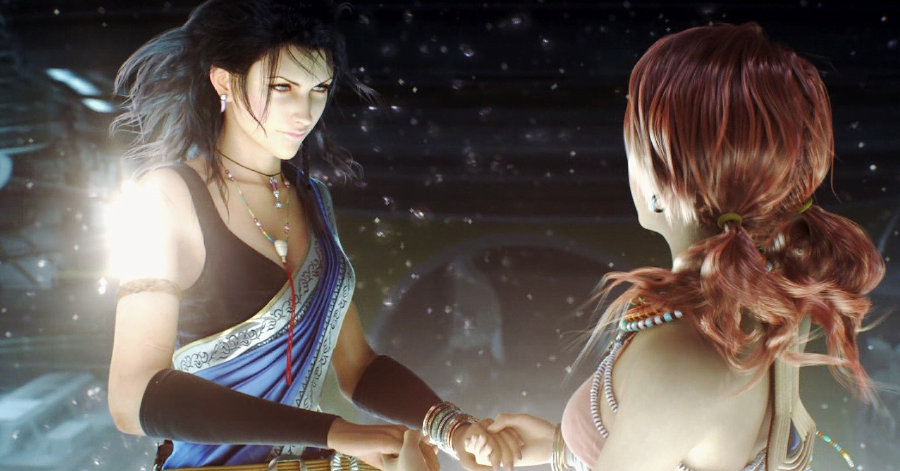
Now the reason I invoked Final Fantasy XIII-2 way back up there at the start of this conversation wasn’t just generic meanspiritedness, though all the research for this article has definitely put me in that mood. A year ago (almost to the day), I mentioned that the critical landscape of videogames was not being hurt because too many people were sharing their takes on critical darlings, and twitter user Kaiterra expressed a longing to see positive takes on Final Fantasy XIII-2.
That’s right, I didn’t forget.
I installed the game that day, and not a word of a lie I have spent a year trying to get into this game enough to enjoy it. I bounce off the tutorial so hard that I find myself literally reaching for other sources to inspire me to continue playing. I thought perhaps the issue I had was that without a pre-existing love for these characters in Final Fantasy XIII, I wasn’t going to care about the mystery of where they were going in XIII-2. I still don’t, by the way. How was I going to digest the mess of Final Fantasy XIII to process XIII-2?
It’s kind of a surrender, here. I think spending a year to finish a tutorial is a sign I’m never going to connect with this game on the primal level of its truest fans. I wouldn’t call it bad or anything like that, because that word is hollow here. The game itself might be great, it might be awful. I want to play a game with Lightning in it, but I don’t want to play this game with Lightning in it. I mean, I’m still playing it, but playing this game is an experience of hooting and hollering at the game as it does silly things I think are goofy, or timing cutscenes and mocking the game for having whole cut scenes that compare to ad break sized chunks of TV shows and being nowhere near as good at it as it thinks.
And so, I look at the root of this, at the creation, the process, the marketing push, and make fun of that. While I rubbish on Fabula Nova Crystallis for being bad, and badly implemented and maybe just a bunch of marketing gibberish that make directors and studio heads look good and connected and resonant with fans even while they are demonstrating a complete ignorance of those fans and their wants, it’s worth remembering something I say a lot these days about the importance of players in the games.
The player in any given game is part of what makes the game work. There’s a lot of a game that is completely inert without the engagement of the player, and the player playing the game is creating an experience – they are literally part of the paratext. This means that games can be stunningly singular, intimate art experiences, even art experiences made out of this garbled capitalistic marketing-toshed nonsense.
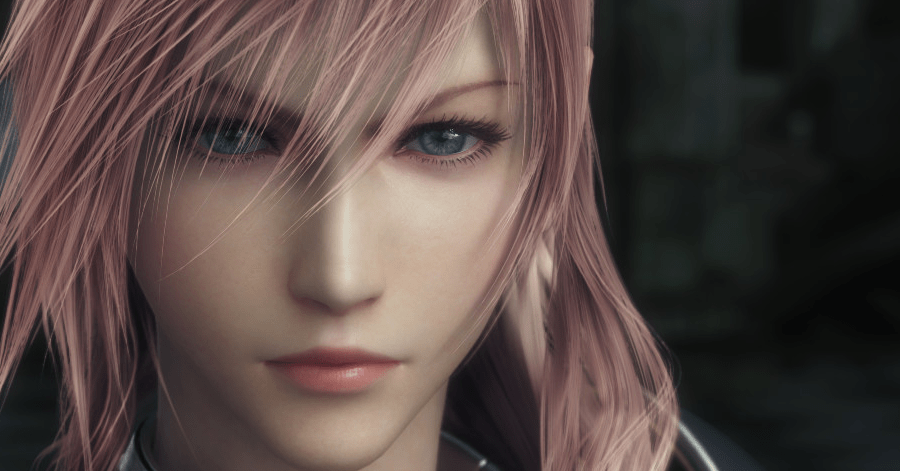
If you love Final Fantasy XIII-2, then you are part of the game you created, and you are whole, and meaningful, and real in that love. The game you played is a game you made with the game bits you were given. You aren’t the maker of the meaningless moral mythical melange of monetised and modernised mistaken mythical mush. You made your experience, you made your game, and that play is more important than any marketing statement about the future direction of Final Fantasy that was given a name, given #brand and given a twisted life.
The people who made these games, at least the first wave of them, were so uncertain as to what their games were actually about that they were able to accidentally a homosexuality and seemingly not even notice. They can put whatever label they want on the claim they had a plan going in, but they don’t have one. Your game, the story you found, the thing you experienced, that’s going to be a much better story than what they’re pretty confident they put there. They have their part to play, but you’re the one who weaves the story together.
If this means your vision of Lightning is a lesbian icon, because you really wanna kiss the futch, sure. If this means you see her deliberate standoffishness as a sign she’s an ace or aro icon, that’s there too. If you think she maybe even, possibly could want to hold hands with (gasp) a boy, that’s an option there as well.
Oh, and also, just because there’s nowhere else for it: Fang is described in the guidebooks as having been formerly a male character, that she wants to protect Vanille due to their commonality, that their voices were chosen to ‘sound different,’ and Fang’s favourite things to eat are salty foods. So if you wanted to interpret her as a trans lesbian, it’s not like it’s not there.
I don’t think Fabula Nova Crystallis is a bad experiment. I’d kinda love it if more games had a mission statement for their underlying cosmological significance. It’s a sign of the difference between a brand and a vision, though. As concepted, the idea was to give games an underlying cosmological purpose that also served as a narrative dimension to give them vision.
I just wish they’d do a good job of it.
